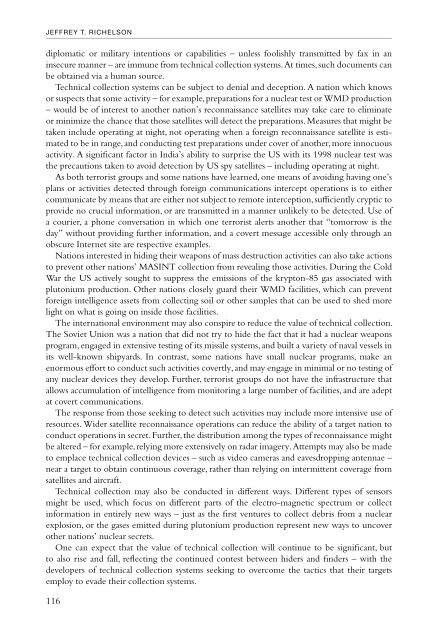Handbook of intelligence studies / edited by
Handbook of intelligence studies / edited by
Handbook of intelligence studies / edited by
Create successful ePaper yourself
Turn your PDF publications into a flip-book with our unique Google optimized e-Paper software.
JEFFREY T. RICHELSON<br />
diplomatic or military intentions or capabilities – unless foolishly transmitted <strong>by</strong> fax in an<br />
insecure manner – are immune from technical collection systems. At times, such documents can<br />
be obtained via a human source.<br />
Technical collection systems can be subject to denial and deception. A nation which knows<br />
or suspects that some activity – for example, preparations for a nuclear test or WMD production<br />
– would be <strong>of</strong> interest to another nation’s reconnaissance satellites may take care to eliminate<br />
or minimize the chance that those satellites will detect the preparations. Measures that might be<br />
taken include operating at night, not operating when a foreign reconnaissance satellite is estimated<br />
to be in range, and conducting test preparations under cover <strong>of</strong> another, more innocuous<br />
activity. A significant factor in India’s ability to surprise the US with its 1998 nuclear test was<br />
the precautions taken to avoid detection <strong>by</strong> US spy satellites – including operating at night.<br />
As both terrorist groups and some nations have learned, one means <strong>of</strong> avoiding having one’s<br />
plans or activities detected through foreign communications intercept operations is to either<br />
communicate <strong>by</strong> means that are either not subject to remote interception, sufficiently cryptic to<br />
provide no crucial information, or are transmitted in a manner unlikely to be detected. Use <strong>of</strong><br />
a courier, a phone conversation in which one terrorist alerts another that “tomorrow is the<br />
day” without providing further information, and a covert message accessible only through an<br />
obscure Internet site are respective examples.<br />
Nations interested in hiding their weapons <strong>of</strong> mass destruction activities can also take actions<br />
to prevent other nations’ MASINT collection from revealing those activities. During the Cold<br />
War the US actively sought to suppress the emissions <strong>of</strong> the krypton-85 gas associated with<br />
plutonium production. Other nations closely guard their WMD facilities, which can prevent<br />
foreign <strong>intelligence</strong> assets from collecting soil or other samples that can be used to shed more<br />
light on what is going on inside those facilities.<br />
The international environment may also conspire to reduce the value <strong>of</strong> technical collection.<br />
The Soviet Union was a nation that did not try to hide the fact that it had a nuclear weapons<br />
program, engaged in extensive testing <strong>of</strong> its missile systems, and built a variety <strong>of</strong> naval vessels in<br />
its well-known shipyards. In contrast, some nations have small nuclear programs, make an<br />
enormous effort to conduct such activities covertly, and may engage in minimal or no testing <strong>of</strong><br />
any nuclear devices they develop. Further, terrorist groups do not have the infrastructure that<br />
allows accumulation <strong>of</strong> <strong>intelligence</strong> from monitoring a large number <strong>of</strong> facilities, and are adept<br />
at covert communications.<br />
The response from those seeking to detect such activities may include more intensive use <strong>of</strong><br />
resources. Wider satellite reconnaissance operations can reduce the ability <strong>of</strong> a target nation to<br />
conduct operations in secret. Further, the distribution among the types <strong>of</strong> reconnaissance might<br />
be altered – for example, relying more extensively on radar imagery. Attempts may also be made<br />
to emplace technical collection devices – such as video cameras and eavesdropping antennae –<br />
near a target to obtain continuous coverage, rather than relying on intermittent coverage from<br />
satellites and aircraft.<br />
Technical collection may also be conducted in different ways. Different types <strong>of</strong> sensors<br />
might be used, which focus on different parts <strong>of</strong> the electro-magnetic spectrum or collect<br />
information in entirely new ways – just as the first ventures to collect debris from a nuclear<br />
explosion, or the gases emitted during plutonium production represent new ways to uncover<br />
other nations’ nuclear secrets.<br />
One can expect that the value <strong>of</strong> technical collection will continue to be significant, but<br />
to also rise and fall, reflecting the continued contest between hiders and finders – with the<br />
developers <strong>of</strong> technical collection systems seeking to overcome the tactics that their targets<br />
employ to evade their collection systems.<br />
116
















